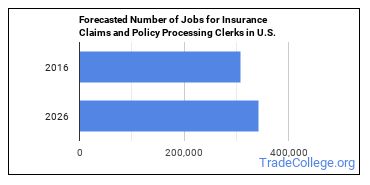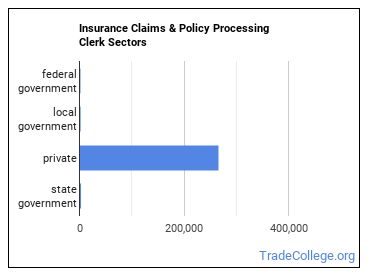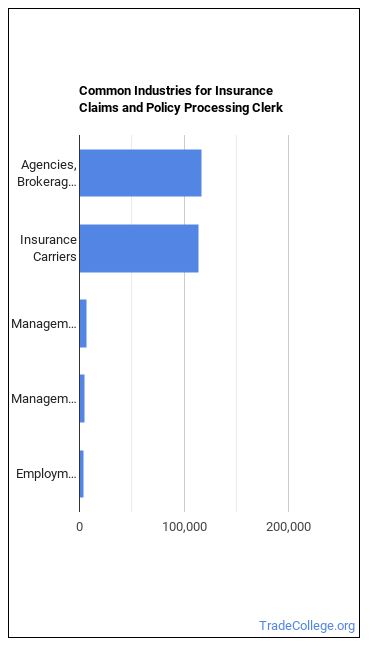All About Insurance Claims and Policy Processing Clerks
Job Description & Duties Process new insurance policies, modifications to existing policies, and claims forms. Obtain information from policyholders to verify the accuracy and completeness of information on claims forms, applications and related documents, and company records. Update existing policies and company records to reflect changes requested by policyholders and insurance company representatives.
Featured schools near , edit
Related Job Titles for this Occupation:
- Insurance Policy Issue Clerk
- Insurance Clerk
- Insurance Examining Clerk
- Underwriting Clerk
- Billing and Insurance Coordinator
Is There Job Demand for Insurance Claims and Policy Processing Clerks?
In 2016, there was an estimated number of 308,500 jobs in the United States for Insurance Claims and Policy Processing Clerk. New jobs are being produced at a rate of 11.1% which is above the national average. The Bureau of Labor Statistics predicts 34,100 new jobs for Insurance Claims and Policy Processing Clerk by 2026. The BLS estimates 35,600 yearly job openings in this field.

The states with the most job growth for Insurance Claims & Policy Processing Clerk are Utah, Arizona, and Iowa. Watch out if you plan on working in Maine, Vermont, or Oregon. These states have the worst job growth for this type of profession.
Salary for an Insurance Claims & Policy Processing Clerk
Insurance Claims and Policy Processing Clerks make between $27,540 and $60,500 a year.

Insurance Claims and Policy Processing Clerks who work in District of Columbia, Connecticut, or Massachusetts, make the highest salaries.
How much do Insurance Claims and Policy Processing Clerks make in different U.S. states?
| State | Annual Mean Salary |
|---|---|
| Alabama | $37,000 |
| Alaska | $42,450 |
| Arizona | $42,760 |
| Arkansas | $35,960 |
| California | $42,690 |
| Colorado | $48,700 |
| Connecticut | $50,300 |
| Delaware | $40,540 |
| District of Columbia | $56,710 |
| Florida | $39,150 |
| Georgia | $46,190 |
| Hawaii | $40,270 |
| Idaho | $40,410 |
| Illinois | $43,540 |
| Indiana | $39,740 |
| Iowa | $43,500 |
| Kansas | $40,350 |
| Kentucky | $34,370 |
| Louisiana | $35,100 |
| Maine | $40,180 |
| Maryland | $47,600 |
| Massachusetts | $48,820 |
| Michigan | $38,310 |
| Minnesota | $44,700 |
| Mississippi | $33,420 |
| Missouri | $40,100 |
| Montana | $39,020 |
| Nebraska | $39,410 |
| Nevada | $40,700 |
| New Hampshire | $44,500 |
| New Jersey | $47,180 |
| New Mexico | $37,360 |
| New York | $48,740 |
| North Carolina | $43,180 |
| North Dakota | $41,610 |
| Ohio | $39,830 |
| Oklahoma | $42,120 |
| Oregon | $43,950 |
| Pennsylvania | $42,590 |
| Rhode Island | $45,300 |
| South Carolina | $36,850 |
| South Dakota | $33,540 |
| Tennessee | $37,880 |
| Texas | $39,950 |
| Utah | $40,940 |
| Vermont | $41,420 |
| Virginia | $42,030 |
| Washington | $45,810 |
| West Virginia | $33,710 |
| Wisconsin | $40,340 |
| Wyoming | $36,190 |
Where Insurance Claims and Policy Processing Clerks Work

Below are examples of industries where Insurance Claims and Policy Processing Clerks work:

References:
More about our data sources and methodologies.
Featured Schools
 Request Info
Request Info
|
Southern New Hampshire University You have goals. Southern New Hampshire University can help you get there. Whether you need a bachelor's degree to get into a career or want a master's degree to move up in your current career, SNHU has an online program for you. Find your degree from over 200 online programs. Learn More > |
